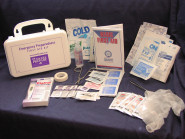Storm Preparedness and Recovery
Important steps New Yorkers should take to be prepared for a storm
- Have plenty of non-perishable food and water supplies on hand. Make sure battery-operated radios and flashlights are available and have an ample supply of batteries. Hand-cranked flashlights and radios that do not need batteries may also be useful. Have a first aid kit available and make sure there is an adequate supply of prescription drugs and other medicines on hand for those who require them.
- Know how to contact all family members at all times. Identify an out-of-town friend or family member to be the "emergency family contact." Then make certain all family members have that number. Designate a family emergency meeting place where the family can meet in case you can't go home.
- Pay particular attention to relatives with special needs, small children and pets. Know where to relocate pets during a storm because most shelters will not accept pets. Shelters will only accept "service animals" that assist people with disabilities.
- Prepare an emergency phone list of people and organizations that may need to be called. Include children's schools, doctors, child/senior care providers, and insurance agents.
- Follow the news and emergency broadcasts of local radio and television stations that will provide up-to-date official information during a storm emergency, including recommendations to evacuate specific areas.
- Find out what emergency plans are in place in your community and how you will be notified in the event of an emergency.
- Know the hurricane risks in your area and learn the storm surge history and elevation of your area.
- Store important documents such as insurance policies, medical records, bank account numbers, and social security cards in waterproof containers. Also have cash (in small bills), checkbook, credit and ATM cards readily available.
Additional Information
- Avoiding Carbon Monoxide Dangers
- Drinking Water Safety
- Food Safety Tips
- Weathering the Storm
- Mold: Preventing and Removing
- Federal & State Flooding Resources
- Helpful Publications
- If Evacuation Becomes Necessary
Disaster Recovery
If you are returning home
- Stay out of damaged buildings and return home only when authorities say it is safe.
- Beware of structural damage. Roofs and floors may be weakened and need repair. When entering a fire-damaged building, look for signs of heat or smoke.
- Check the building foundation, chimney, and surrounding land for damage.
- Turn off any outside gas lines at the meter or tank. Let the building air out to remove foul odors or escaping gas.
- Upon entering the building, use a battery-powered flashlight. Do not use an open flame as a source of light—some gas may still be trapped inside.
- When inspecting the building, wear heavy-soled rubber boots and gloves. Watch for electrical shorts and live wires before making certain the main power switch is off.
- Have electric, gas, and water connections checked before turning them back on.
- Clean up spilled medicines, bleaches, or gasoline or other flammable liquids immediately. Leave area immediately if you smell gas or chemical fumes.
- Take extra precautions to prevent fire. Lowered pressure in water mains may make firefighting extremely difficult.
- Take pictures of damages, keep records of all clean up and repair costs, and report to your insurance company.
- Do not throw away any damaged goods until an official inventory has been taken.
